Scythe Infinity: 5 Heatpipes and Silent 120mm Fan
by Wesley Fink on February 26, 2007 12:05 AM EST- Posted in
- Cases/Cooling/PSUs
Scythe Infinity
Scythe Co., Ltd. is a Japanese company located in Tokyo. Beginning in 2002 Scythe started manufacturing and distributing products for the PC enthusiast. This included CPU cooling solutions. Scythe's first product, the Scythe Samurai, developed quite a reputation among computer enthusiasts.
Scythe produces a wide range of air cooling solutions for the computer enthusiast. There are currently about a dozen air cooling solutions detailed on the company website. These range from entry cooling solutions all the way to full cooling tower designs.
Their current catalog includes the well-known Scythe Infinity and the Scythe Ninja Rev. B full cooling tower solutions at the top. There are also mid to low-end offerings such as the Scythe Katana that was recently reviewed at AnandTech.
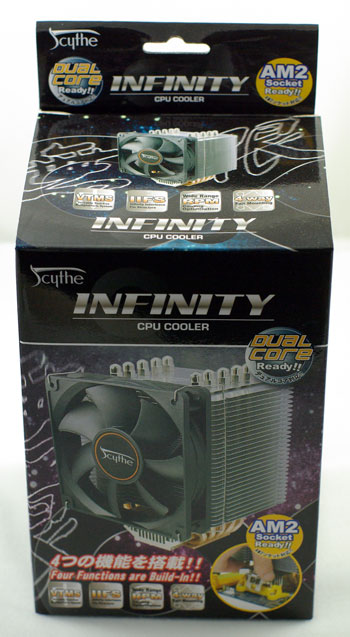
Scythe likes using colorful graphics, but they often put so much information in so many languages on the box that the packaging becomes confusing. The Infinity is a big heatpipe tower, and Scythe use every inch of that big package for information. You can find whatever you want to know about Infinity on the package somewhere - it's just finding what you are looking for is not so easy in that package information explosion.
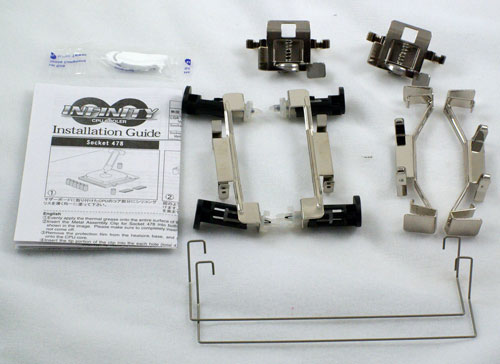
Infinity comes with adapters for 775, AM2, and AMD 754/939/940. The Scythe adapter system is extremely easy to use. Adapters pop into holes on the side of the tower base and no tools are needed for mounting the adapters. It's a very clever mount system.
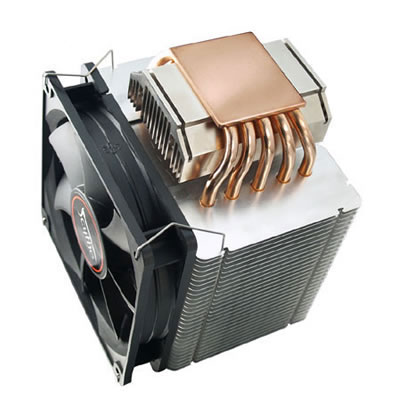
The mounting surface of Infinity is highly polished. It is protected during shipments with an adhesive film that removes leaving no residue.
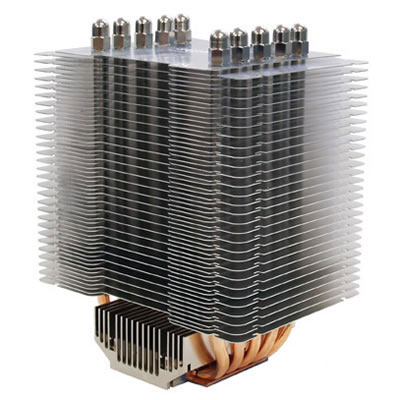
At first glance it looks as if the Scythe Infinity uses ten heatpipes for cooling, but Scythe specifies the configuration as five heat pipes. The 5 pipes flatten out and pass across the base copper plate, so they form a continuous "U" shape with each heatpipe.
Scythe supplies a packet of very basic thermal compound with the Infinity, but it is nothing special. We used our standard silver-colored thermal grease in our testing, which is what we use in testing all coolers unless they supply a high-end thermal grease with the cooler.
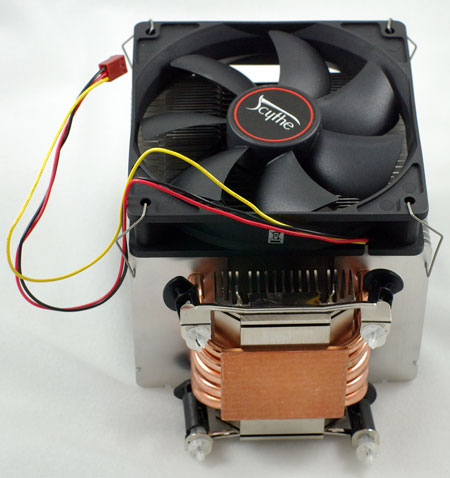
The included low-noise fan can fit on any of the 4 sides of the cooler. Scythe tells us mounting on the larger side of the Infinity provides the best cooling, but the fan may also be mounted on the shorter side if that works better in your configuration.
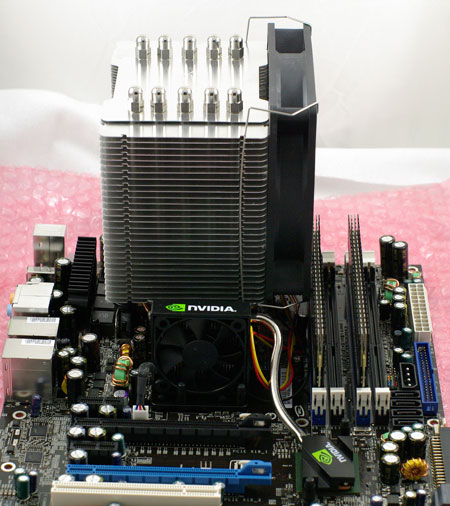
Installation is very easy after the mounting plate is installed. The 775 mount uses push pins - just like the Intel retail design. However easy the mount is, the fact that the Infinity weighs right at 2.2 lbs, or a kilogram, gives reason for pause. It is very uncomfortable having so much weight held by just those pop clips. The Infinity is probably OK in a desktop case, but it is not a mounting system that handles moving the case around or transport to and from a LAN party.
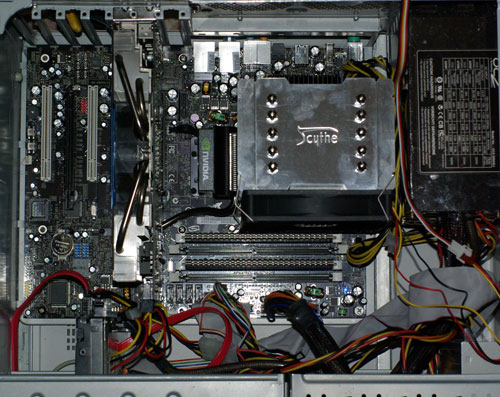
The Infinity does not overhang the DIMM sockets on the EVGA 680i as you can see in the picture above. The fan does come very close however. The mass of the Infinity is also a bit closer to the motherboard than some other heatpipe towers, so the Infinity can be a tight fit on some motherboards. In our installation the EVGA cooling fan on the Northbridge touched the Infinity, meaning the Infinity has to be very carefully aligned on installation. In our first attempt stock idle cooling was 36C, which appeared very high. After a careful remount the stock idle temp dropped to 31C, which was more in line with expected performance.
Specifications
Our test system is Intel Socket 775, but the Scythe Infinity will mount on any current CPU, as already mentioned. All the needed hardware is included to fit the supported sockets.
One 120mm "silent" fan comes with the Scythe Infinity. The Infinity street price is $58, about the same as the current price of the Tuniq Tower 120. If you cannot find a local retailer or etailer that sells the Infinity you can order directly from Scythe USA for $58. Scythe also sells additional fan wires for about $2 per pair. Many etailers also stock the fan wire kits. Any 120mm x 25mm fan should mount on the Infinity. Scythe also manufactures a very large variety of cooling fans sold under the Scythe brand, including models that feature the Sony Fluid Dynamic Bearing. You will find many of these available at etailers like Newegg, 3DCool and Frozen CPU.
Scythe Co., Ltd. is a Japanese company located in Tokyo. Beginning in 2002 Scythe started manufacturing and distributing products for the PC enthusiast. This included CPU cooling solutions. Scythe's first product, the Scythe Samurai, developed quite a reputation among computer enthusiasts.
Scythe produces a wide range of air cooling solutions for the computer enthusiast. There are currently about a dozen air cooling solutions detailed on the company website. These range from entry cooling solutions all the way to full cooling tower designs.
Their current catalog includes the well-known Scythe Infinity and the Scythe Ninja Rev. B full cooling tower solutions at the top. There are also mid to low-end offerings such as the Scythe Katana that was recently reviewed at AnandTech.

Scythe likes using colorful graphics, but they often put so much information in so many languages on the box that the packaging becomes confusing. The Infinity is a big heatpipe tower, and Scythe use every inch of that big package for information. You can find whatever you want to know about Infinity on the package somewhere - it's just finding what you are looking for is not so easy in that package information explosion.

Infinity comes with adapters for 775, AM2, and AMD 754/939/940. The Scythe adapter system is extremely easy to use. Adapters pop into holes on the side of the tower base and no tools are needed for mounting the adapters. It's a very clever mount system.

The mounting surface of Infinity is highly polished. It is protected during shipments with an adhesive film that removes leaving no residue.

At first glance it looks as if the Scythe Infinity uses ten heatpipes for cooling, but Scythe specifies the configuration as five heat pipes. The 5 pipes flatten out and pass across the base copper plate, so they form a continuous "U" shape with each heatpipe.
Scythe supplies a packet of very basic thermal compound with the Infinity, but it is nothing special. We used our standard silver-colored thermal grease in our testing, which is what we use in testing all coolers unless they supply a high-end thermal grease with the cooler.

The included low-noise fan can fit on any of the 4 sides of the cooler. Scythe tells us mounting on the larger side of the Infinity provides the best cooling, but the fan may also be mounted on the shorter side if that works better in your configuration.

Installation is very easy after the mounting plate is installed. The 775 mount uses push pins - just like the Intel retail design. However easy the mount is, the fact that the Infinity weighs right at 2.2 lbs, or a kilogram, gives reason for pause. It is very uncomfortable having so much weight held by just those pop clips. The Infinity is probably OK in a desktop case, but it is not a mounting system that handles moving the case around or transport to and from a LAN party.

The Infinity does not overhang the DIMM sockets on the EVGA 680i as you can see in the picture above. The fan does come very close however. The mass of the Infinity is also a bit closer to the motherboard than some other heatpipe towers, so the Infinity can be a tight fit on some motherboards. In our installation the EVGA cooling fan on the Northbridge touched the Infinity, meaning the Infinity has to be very carefully aligned on installation. In our first attempt stock idle cooling was 36C, which appeared very high. After a careful remount the stock idle temp dropped to 31C, which was more in line with expected performance.
Specifications
Our test system is Intel Socket 775, but the Scythe Infinity will mount on any current CPU, as already mentioned. All the needed hardware is included to fit the supported sockets.
| Scythe Infinity Specifications | |
| Heatsink | |
| Dimensions | 116(L) X 125(W) X 160(H)mm (excluding fan) |
| Weight | 960g (including fan) |
| Material | Pure Copper and Aluminum |
| Fan Configuration | 4-way mount, up to four 120mm Fans can be mounted |
| Fan | |
| Fan Size | 120mm x 120mm x 25mm |
| Noise Level | 23.5 dB-A |
| Speed | 1200 rpm +/- 10% |
| Air Flow | 46.5 CFM |
One 120mm "silent" fan comes with the Scythe Infinity. The Infinity street price is $58, about the same as the current price of the Tuniq Tower 120. If you cannot find a local retailer or etailer that sells the Infinity you can order directly from Scythe USA for $58. Scythe also sells additional fan wires for about $2 per pair. Many etailers also stock the fan wire kits. Any 120mm x 25mm fan should mount on the Infinity. Scythe also manufactures a very large variety of cooling fans sold under the Scythe brand, including models that feature the Sony Fluid Dynamic Bearing. You will find many of these available at etailers like Newegg, 3DCool and Frozen CPU.










39 Comments
View All Comments
dtanner - Monday, February 26, 2007 - link
By keeping the tower short, you are keeping the mass of the tower closer to the mobo and thus reducing the stress on the push pins. As another poster has stated, with this much mass I would definitely spend the extra $10 and get the UNIVERSAL RETENTION KIT "SCURK1".chienpourri - Monday, February 26, 2007 - link
Juste a suggestion, Scyte sells a UNIVERSAL RETENTION KIT "SCURK1" that anyone can find for around 10$, it comes with a backplate and everything. As the reviewer said, I would feel very uncomfy sitting the Infinity with only brackets... However using this kit it would fix the problem. The only downside I can find is the increased cost, but 10$ for security sounds good to me!orion23 - Monday, February 26, 2007 - link
Yeah...That!orion23 - Monday, February 26, 2007 - link
Hi!Great test guys!
I love how Anandtech started testing and reviewing other PC components.
You guys are doing great so far! Keep them coming...
And don't forget Power Supply Units!
Calin - Monday, February 26, 2007 - link
I find it somewhat to be understood - as the air would flow worse inside the cooler, part of it will flow out of it using the lateral spaces - as such, contributing very little or not at all to cooling.I wonder how much would single fan cooling improve if the air flow would be restricted in escaping by the sides. If so, what the performance would be with a push-pull configuration and lateral restrictions on air movement (escape)?
Jjoshua2 - Monday, February 26, 2007 - link
What I want to see is a more head to head test, with either the Tuniq using fans at the Infinity noise level, or the Infinity getting two higher powered fans, to see which wins.What I am interested in is the best performing silent/near silent fan & heatsink combo.
But overall, I liked the article thanks!
Wesley Fink - Monday, February 26, 2007 - link
We appreciate your suggestion, but we make every effort to test CPU coolers as they are packaged if at all possible. It would be a massive effort to try to go through an assortment of fans, find those singles and pairs that noise match and then replace fans supplied with the coolers with these matched singles and pairs. HSFs like Zalman have embedded fans which can't be swapped, and many top coolers use fan sizes with more limited selections than the 92mm or 120mm fan sizes.You have an interesting idea for an article on silent cooling, but it does go beyond the bounds of benchmarking and comparing performance of CPU coolers.
crimson117 - Monday, February 26, 2007 - link
What is the ambient temperature in the room during testing?Does the room get hotter after a few hours of testing, perhaps skewing temperatures higher for models tested at the end of the day?
Wesley Fink - Monday, February 26, 2007 - link
The ambient temperature of the room is 69F (21C) and is reasonably consistent. When running many computers in benchmarking the temperature may rise to 75F, but we check the temperature and turn off other systems during cooler testing.